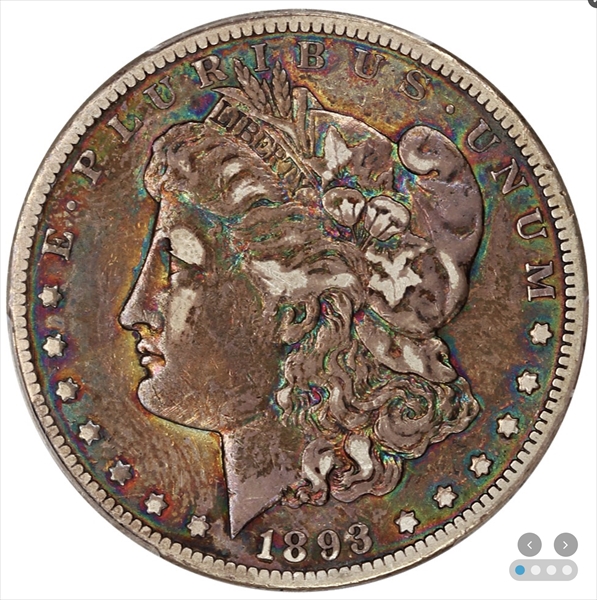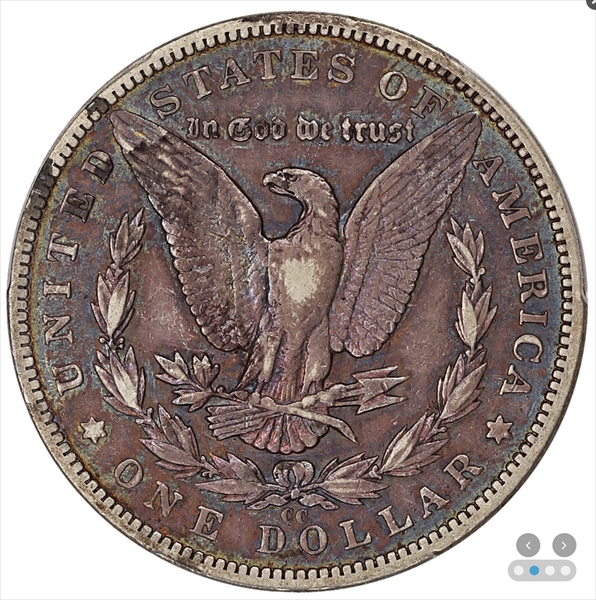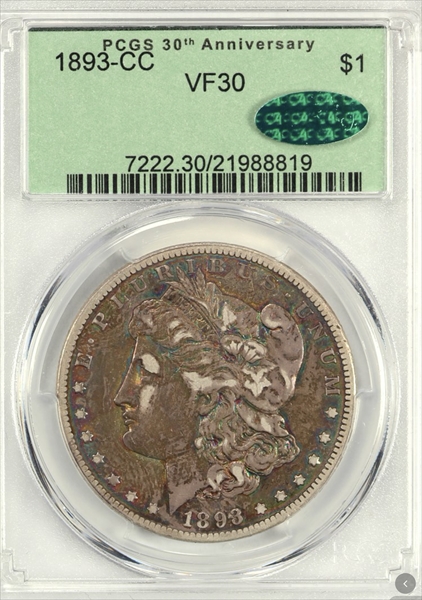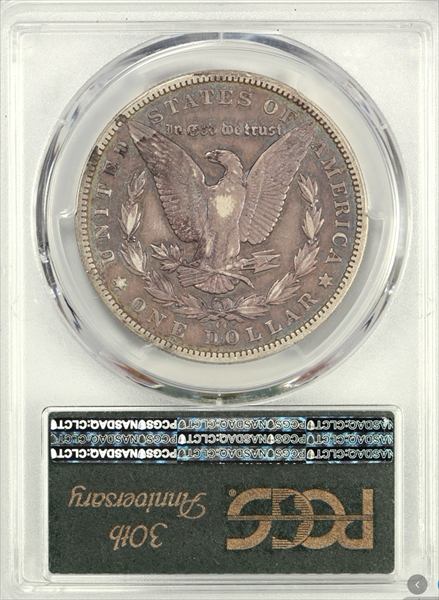1893-CC $1 VF30 认证号21988819, PCGS号7222
拥有者评论
专家评论
Ron Guth
The 1893-CC $1 is an immensely popular coin because of its Mint of origin, the fact that it is the last of the CC Dollars, and because sufficient quantities remain to make it easy to obtain. The 1893-CC, along with the 1889-CC and the 1879-CC, is one of the three scarcest Morgan Dollars. Interestingly, the PCGS Population Report shows similar quantities of each, but breaking down the data shows dissimilar patterns. The 1889-CC is a great rarity in Mint State and is so valuable in all grades that thousands of circulated examples have been sent in for grading. The 1879-CC comes in two varieties (Clear and Capped Mintmarks) but, here again, a substantial percentage of submissions are of circulated examples. Not so with the 1893-CC, where the bulk of the population rests within the Mint State range. However, because of poor storage, the overall quality of the 1893-CC Dollars is lower than for both the 1879-CC and 1889-CC Dollars. The typical 1893-CC Dollar shows excessive bagmarks and sometimes comes weakly struck in the centers, as evidenced by flat hair over Liberty's ear and flat feathers on the eagle's breast. Gem 1893-CC Dollars are very rare, more so than the 1879-CC and 1889-CC, and the finest 1893-CC $1 is a single PCGS MS-66.
Branch Mint Proofs exist of this date (see PCGS nos. 7347 and 388529).
Q. David Bowers
The following narrative, with minor editing, is from my "Silver Dollars & Trade Dollars of the United States: A Complete Encyclopedia" (Wolfeboro, NH: Bowers and Merena Galleries, Inc., 1993)Coinage Context
End of an era: In 1893, the Carson City Mint was closed to further coinage, although it remained in business as an assay office and refinery. Thus ended an era in American coinage and numismatic history. The Carson City Mint had produced coins from 1870 to 1885 and again from 1889 to 1893. Silver dollars were produced from 1870 through 1873, from 1878 through 1885, and from 1889 through 1893. Trade dollars were minted there from 1873 through 1878. Today the Carson City Mint building still stands and since 1942 has been operated as the Nevada State Museum.
Numismatic Information
Commentary: The 1893-CC dollar has always been a collectors' favorite, due to its scarcity and its position as the last Carson City Mint coin of its denomination. In terms of availability in Mint State, it is third rarest after 1889-CC (rarest) and 1879-CC.
Hoard coins: Mint bags of 1893-CC dollars came on the market as early as 1920 at face value through the Cash Room at the Treasury in Washington and, in particular, from storage at the San Francisco Mint. However, the quantity was small in comparison to certain other Carson City dates, particularly those of the early and mid-1880s. The supply seems to have been exhausted by the late 1950s, and there are no records of any quantities being paid out after that time. However, during the 1950s the 1893-CC was sufficiently plentiful that Harry J. Forman handled at least 10 bags (10,000 coins), and other quantities were bought and sold by other dollar specialists.
One solitary coin turned up in the General Services Administration's holding held back in March 1964. The Redfield estate contained several thousand coins, most of which were severely damaged (see "An unfortunate situation" below). These probably came from storage at the San Francisco Mint and were probably paid out in the 1950s.
In the modern market, groups of 1893-CC dollars are seldom seen. John V. Kamin observed this:(Letter to the author, October 29, 1992.)
A BU roll of these appeared at the October 1992 Long Beach Coin Show, the first roll that I have seen on the market in five years. Our clients bought five coins out of that BU roll. It is typical for 1893-CC to appear by the roll only once or twice every five years. Most 1893-CCs trade by the single coin. A "hoard" today would be four rolls.
A 1955 release: As noted, in the 1950s, quantities of Carson City Mint dollars came on the market. In the December 1955 issue of The Numismatist, the following appeared under the title "More Silver Dollars Escape:"
It is reported by the Great Falls, Mont., Tribune that one thousand U.S. silver dollars, minted in Carson City, Nev., in 1893, were placed in circulation there during the last week of October. The Montana Bank received the coins in a routine shipment from the Minneapolis Federal Reserve Bank. Most of the dollars were distributed in regular banking operations before their value to collectors was realized. As only 677,000 were minted, the pieces catalog at $9 Very Fine and $65 Uncirculated.
Circulated grades: In worn grades the 1893-CC is one of the scarcer Morgan dollar varieties. Most circulated dollars are in lower grade levels such as VG-8 and F-12, indicating that such coins were used in commerce for a long time.
Mint State grades: Most Mint State coins are very lustrous. Of all Carson City Mint Morgan dollars, the 1893-CC is notorious for being very heavily bagmarked. The vast majority of extant Mint State coins are in lower levels and have extensive marking. High-grade, mark-free coins are very rare. In fact, although 1893-CC dollars were plentiful a generation ago, Mint State coins are decidedly rare at any level today. Even MS-60 to 62 coins, heavily bagmarked, are apt to show up just one at a time. It has been a long time since I have been offered a roll of 20 pieces.
The striking of 1893-CC dollars varies. The typical piece is apt to have some flatness at the obverse center and, on the reverse, weak breast feathers on the eagle. Sharply struck coins do exist and are in the distinct minority. Once again, cherrypicking is the order of the day for the discriminating buyer. Leave the weak coins to unknowing, uncaring investors.
Most 1893-CC dollars grade from MS-60 to 62 and, as noted, are heavily bagmarked. At this level, probably 15,000 to 30,000 coins exist. MS-63 coins are scarce; an estimated 2,000 to 4,000 survive. MS-64 coins are rare, and it is likely that no more than 1,000 to 2,000 survive. In MS-65 or better grade only 50 to 100 are known. MS-65 specimens are sufficiently elusive that even the most seasoned dealer in dollars will get excited if one is offered.
As is the case with all other CC dollars, only a small percentage of extant 1893-CC dollars have been certified.
Incompetence: In his Morgan and Peace Dollar Textbook, Wayne Miller related the following:
One of the most amazing acts of incompetence in the history of numismatics occurred during the dispersal of the Redfield hoard. Apparently the company which was engaged to inventory and appraise the hoard ran several thousand Mint State dollars through a coin counter! The damage was most evident with the 1893-CC dollars, many of which evidenced a large, very noticeable scrape on Liberty's cheek or the eagle's breast. Although most of these dollars are well struck, with good lustre, they are virtually unsalable.
Prooflike coins: Prooflike coins are usually lightly struck at the centers. Prooflike pieces are fairly scarce, and well struck they are rare. DMPL coins are about 10 times rarer than PL and are especially rare if well struck. Of the 11 DMPL coins certified by NGC and PCGS as of September 1992, none was better than MS-64.
Varieties
Circulation strikes:
1. Normal date: Breen-5633. The five varieties listed by VAM are from four obverse dies and three reverses.
Dies prepared: Obverse: 10; Reverse: 5
Circulation strike, mintage: 677,000; Delivery figures by month: January: 130,000; February: 150,000; March: 140,000; April: 120,000; May: 137,000; June-December: none.
Mint ended coinage June 1.
Specimens sent to the Assay Commission: 339 Estimated quantity melted: Probably several hundred thousand under the 1918 Pittman Act.
Availability of prooflike coins: Prooflike specimens are elusive, and are usually flatly struck at the centers. DMPL coins are exceedingly rare.
Characteristics of striking: Usually weakly struck at the center, but exceptions exist.
Known hoards of Mint State coins: Scattered bags were released in the 1950s. Harry J. Forman handled at least 10 bags (10,000 coins). An esti-mated several thousand coins, damaged by a coin counting machine, were sold from the Redfield estate in the 1970s.
Commentary
The 1893-CC is the last Carson City Mint silver dollar issue. Mint State examples are usually seen heavily bagmarked.
Additional Information
Finis to the Mint
The Annual Report of the Director of the Mint 1893, told of the end of coinage at the Carson City Mint:
"By direction of the secretary of the Treasury coinage operations at the mint at Carson City were suspended on June 1, 1893, and the force employed in the coiner's department dispensed with. A corresponding reduction was also made in other departments of the mint.
"The business of the Carson mint is now conducted on the same basis as that of the assay office at New York; depositors of gold receiving payment either in coin or fine bars, as preferred, and of silver, in unparted or fine bars. Until the repeal of the purchasing clause of the Act of July 14, 1890, depositors of silver at the Carson City Mint could sell their silver to the government and receive payment therefore over the counter in the Treasury notes or by draft on the assistant treasurer of the United States at San Francisco or New York, payable in Treasury notes.
"The mint at Carson City being of limited capacity, and the amount of gold deposited and silver purchased there being small as compared with the amount of gold deposited and silver purchased at the San Francisco Mint, which possesses a large coinage capacity, the expenses for coinage were much greater at Carson than at San Francisco.
"The gold deposited at the mint at Carson City can be transported to the mint at San Francisco and converted into coin without any additional appropriation either for labor or contingent expenses. The heavy outlay for coinage at the former and the accumulation of an amount of gold coin at a point where it is not required for use may be thus avoided.
"Upon the suspension of coinage operations at the Carson Mint the presses and other machinery used in the coinage department were painted and leaded under the supervision of Mr. Charles H. Colburn, the retiring coiner, to prevent corrosion.' At the close of the fiscal year 1893 the bullion, coin and other moneys with which the superintendent was charged was weighed and counted by Messrs. W.E. Morgan and A.A. Hassan, of the Bureau of the Mint, and the amount found to be correct."
1893-CC Dollars Assayed
On February 14, 1894 the assay commission met at Philadelphia. Among the coins considered for assay were 339 1893-CC silver dollars.
Heaton On Collecting Carson City Dollars
In his study, A Treatise on the Coinage of the United States Branch Mints, 1893, Augustus G. Heaton commented as follows:
"1893 has a medium CC over the space between D and O[of DOLLAR]. The first C is higher than the second. However, in the Carson City dollars from 1878 to '93 the differences are so trivial that. .. we will leave further study of the millions of pieces [sic] annually issued to individual pleasure, assured that very few will burden their drawers [in coin cabinets] with more than a specimen of each mintmark date."
Later Carson City Reports
The Carson City facility continued to be mentioned in the Annual Report of the Director of the Mint. Selected excerpts follow from the fiscal years indicated:
1896. The Annual Report of the Director of the Mint, 1896, gave a multi-page detailed report on a theft from the Carson City Mint. The situation was so important that, according to the report: "Owing to the investigation and trials of the persons charged with the embezzlement of gold bullion from the melter and refiner's department, the refinery has not been operated during the year, and the business of this mint was limited to the receipt of gold deposits only." The matter ended as follows: 'John T. Jones, assistant melter and refiner, and James Heany, silver dissolver, have been convicted and sentenced to a term of eight years' imprisonment and to pay a fine of $5,000."
1897. Report of silver dollar storage and distribution. In mint July 1, 1896, 5,137,118; total, 5,137,118; in mint July 1, 1897,5,096,125; distributed from mint 40,993.
1898. Report of silver dollar storage and distribution. In mint July 1, 1897, 5,096,125; total, 5,096,125; in mint July 1, 1898, 5,039,437; total, 5,039,437; distributed from mint, 56,688.
A review of history in the same issue noted that coinage at Carson City was suspended on March 28, 1885. On November 6, 1885 it was directed that the mint be closed. The facility remained closed to the receipt of deposits until October 1, 1887, when it was reopened. On October 1, 1889 coinage was resumed, which continued through May 1893, "though at times the supply of bullion was difficult to obtain, as the amount of deposits was small, and both refinery and coinage operations were restricted. It was necessary on two or three occasions to furlough a large number of the force. The coiner was removed, to take effect July 1, 1893, for want of occupation."
1899: Silver dollar storage and distribution: In mint July 1, 1898, 5,039,437; total, 5,039,437; in mint, July 1, 1899, 5,008,552; total, 5,008,552; distributed from mint, 30,885.
In this same year, coinage presses from Carson City were shipped to other mints. The change in status of the Carson City Mint and Assay Office was effective July 1, 1899.
1900: Silver dollar storage and distribution: In mint July 1, 1899, 5,008,552; total, 5,008,552; transferred from the mint to Treasury, 5,000,000;1 in mint July 1, 1900,7,047; total, 5,007,047; distributed from mint, 1,505. It is especially significant to note that five million Carson City dollars were transferred during the above period indicated.
1901: Silver dollar storage and distribution: In the mint July 1, 1900, 7,047; total, 7,047; distributed from mint, 7,047. The Carson City Mint distributed the 7,047 dollars on hand at the beginning of the fiscal year. At the end of the fiscal year it was left with a balance of no silver dollars.
1903: A note advised readers that from its beginning in 1870 to its discontinuation in 1893, the Carson City Mint struck 13,881,329 silver dollars and 4,211,400 trade dollars.
稀有性和存量估计 了解更多
| 所有评级 | 48000 |
| 60或以上 | 26000 |
| 65或以上 | 30 |
| 所有评级 | R-2.5 |
| 60或以上 | R-2.7 |
| 65或以上 | R-8.9 |
| 所有评级 | 26 / 117 TIE |
| 60或以上 | 36 / 117 TIE |
| 65或以上 | 14 / 117 TIE |
| 所有评级 | 26 / 117 TIE |
| 60或以上 | 36 / 117 TIE |
| 65或以上 | 14 / 117 TIE |




























